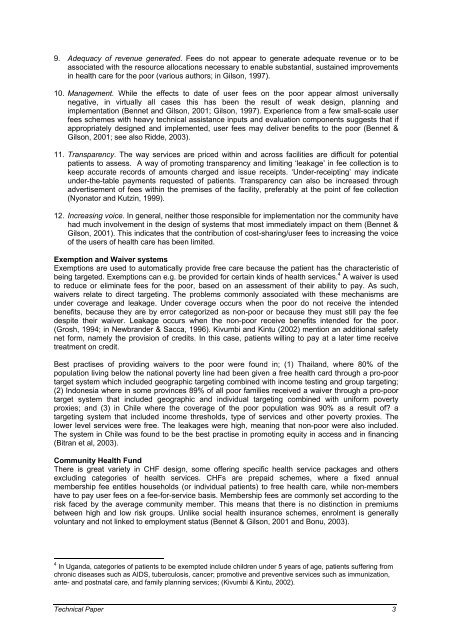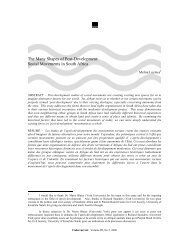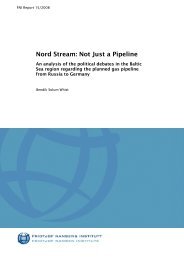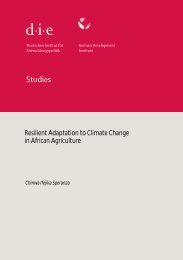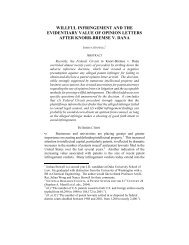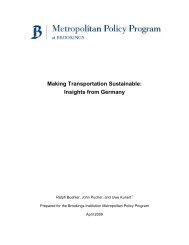equity implications of health sector user fees in tanzania
equity implications of health sector user fees in tanzania
equity implications of health sector user fees in tanzania
Create successful ePaper yourself
Turn your PDF publications into a flip-book with our unique Google optimized e-Paper software.
9. Adequacy <strong>of</strong> revenue generated. Fees do not appear to generate adequate revenue or to be<br />
associated with the resource allocations necessary to enable substantial, susta<strong>in</strong>ed improvements<br />
<strong>in</strong> <strong>health</strong> care for the poor (various authors; <strong>in</strong> Gilson, 1997).<br />
10. Management. While the effects to date <strong>of</strong> <strong>user</strong> <strong>fees</strong> on the poor appear almost universally<br />
negative, <strong>in</strong> virtually all cases this has been the result <strong>of</strong> weak design, plann<strong>in</strong>g and<br />
implementation (Bennet and Gilson, 2001; Gilson, 1997). Experience from a few small-scale <strong>user</strong><br />
<strong>fees</strong> schemes with heavy technical assistance <strong>in</strong>puts and evaluation components suggests that if<br />
appropriately designed and implemented, <strong>user</strong> <strong>fees</strong> may deliver benefits to the poor (Bennet &<br />
Gilson, 2001; see also Ridde, 2003).<br />
11. Transparency. The way services are priced with<strong>in</strong> and across facilities are difficult for potential<br />
patients to assess. A way <strong>of</strong> promot<strong>in</strong>g transparency and limit<strong>in</strong>g ‘leakage’ <strong>in</strong> fee collection is to<br />
keep accurate records <strong>of</strong> amounts charged and issue receipts. ‘Under-receipt<strong>in</strong>g’ may <strong>in</strong>dicate<br />
under-the-table payments requested <strong>of</strong> patients. Transparency can also be <strong>in</strong>creased through<br />
advertisement <strong>of</strong> <strong>fees</strong> with<strong>in</strong> the premises <strong>of</strong> the facility, preferably at the po<strong>in</strong>t <strong>of</strong> fee collection<br />
(Nyonator and Kutz<strong>in</strong>, 1999).<br />
12. Increas<strong>in</strong>g voice. In general, neither those responsible for implementation nor the community have<br />
had much <strong>in</strong>volvement <strong>in</strong> the design <strong>of</strong> systems that most immediately impact on them (Bennet &<br />
Gilson, 2001). This <strong>in</strong>dicates that the contribution <strong>of</strong> cost-shar<strong>in</strong>g/<strong>user</strong> <strong>fees</strong> to <strong>in</strong>creas<strong>in</strong>g the voice<br />
<strong>of</strong> the <strong>user</strong>s <strong>of</strong> <strong>health</strong> care has been limited.<br />
Exemption and Waiver systems<br />
Exemptions are used to automatically provide free care because the patient has the characteristic <strong>of</strong><br />
be<strong>in</strong>g targeted. Exemptions can e.g. be provided for certa<strong>in</strong> k<strong>in</strong>ds <strong>of</strong> <strong>health</strong> services. 4 A waiver is used<br />
to reduce or elim<strong>in</strong>ate <strong>fees</strong> for the poor, based on an assessment <strong>of</strong> their ability to pay. As such,<br />
waivers relate to direct target<strong>in</strong>g. The problems commonly associated with these mechanisms are<br />
under coverage and leakage. Under coverage occurs when the poor do not receive the <strong>in</strong>tended<br />
benefits, because they are by error categorized as non-poor or because they must still pay the fee<br />
despite their waiver. Leakage occurs when the non-poor receive benefits <strong>in</strong>tended for the poor.<br />
(Grosh, 1994; <strong>in</strong> Newbrander & Sacca, 1996). Kivumbi and K<strong>in</strong>tu (2002) mention an additional safety<br />
net form, namely the provision <strong>of</strong> credits. In this case, patients will<strong>in</strong>g to pay at a later time receive<br />
treatment on credit.<br />
Best practises <strong>of</strong> provid<strong>in</strong>g waivers to the poor were found <strong>in</strong>; (1) Thailand, where 80% <strong>of</strong> the<br />
population liv<strong>in</strong>g below the national poverty l<strong>in</strong>e had been given a free <strong>health</strong> card through a pro-poor<br />
target system which <strong>in</strong>cluded geographic target<strong>in</strong>g comb<strong>in</strong>ed with <strong>in</strong>come test<strong>in</strong>g and group target<strong>in</strong>g;<br />
(2) Indonesia where <strong>in</strong> some prov<strong>in</strong>ces 89% <strong>of</strong> all poor families received a waiver through a pro-poor<br />
target system that <strong>in</strong>cluded geographic and <strong>in</strong>dividual target<strong>in</strong>g comb<strong>in</strong>ed with uniform poverty<br />
proxies; and (3) <strong>in</strong> Chile where the coverage <strong>of</strong> the poor population was 90% as a result <strong>of</strong>? a<br />
target<strong>in</strong>g system that <strong>in</strong>cluded <strong>in</strong>come thresholds, type <strong>of</strong> services and other poverty proxies. The<br />
lower level services were free. The leakages were high, mean<strong>in</strong>g that non-poor were also <strong>in</strong>cluded.<br />
The system <strong>in</strong> Chile was found to be the best practise <strong>in</strong> promot<strong>in</strong>g <strong>equity</strong> <strong>in</strong> access and <strong>in</strong> f<strong>in</strong>anc<strong>in</strong>g<br />
(Bitran et al, 2003).<br />
Community Health Fund<br />
There is great variety <strong>in</strong> CHF design, some <strong>of</strong>fer<strong>in</strong>g specific <strong>health</strong> service packages and others<br />
exclud<strong>in</strong>g categories <strong>of</strong> <strong>health</strong> services. CHFs are prepaid schemes, where a fixed annual<br />
membership fee entitles households (or <strong>in</strong>dividual patients) to free <strong>health</strong> care, while non-members<br />
have to pay <strong>user</strong> <strong>fees</strong> on a fee-for-service basis. Membership <strong>fees</strong> are commonly set accord<strong>in</strong>g to the<br />
risk faced by the average community member. This means that there is no dist<strong>in</strong>ction <strong>in</strong> premiums<br />
between high and low risk groups. Unlike social <strong>health</strong> <strong>in</strong>surance schemes, enrolment is generally<br />
voluntary and not l<strong>in</strong>ked to employment status (Bennet & Gilson, 2001 and Bonu, 2003).<br />
4 In Uganda, categories <strong>of</strong> patients to be exempted <strong>in</strong>clude children under 5 years <strong>of</strong> age, patients suffer<strong>in</strong>g from<br />
chronic diseases such as AIDS, tuberculosis, cancer; promotive and preventive services such as immunization,<br />
ante- and postnatal care, and family plann<strong>in</strong>g services; (Kivumbi & K<strong>in</strong>tu, 2002).<br />
Technical Paper 3


